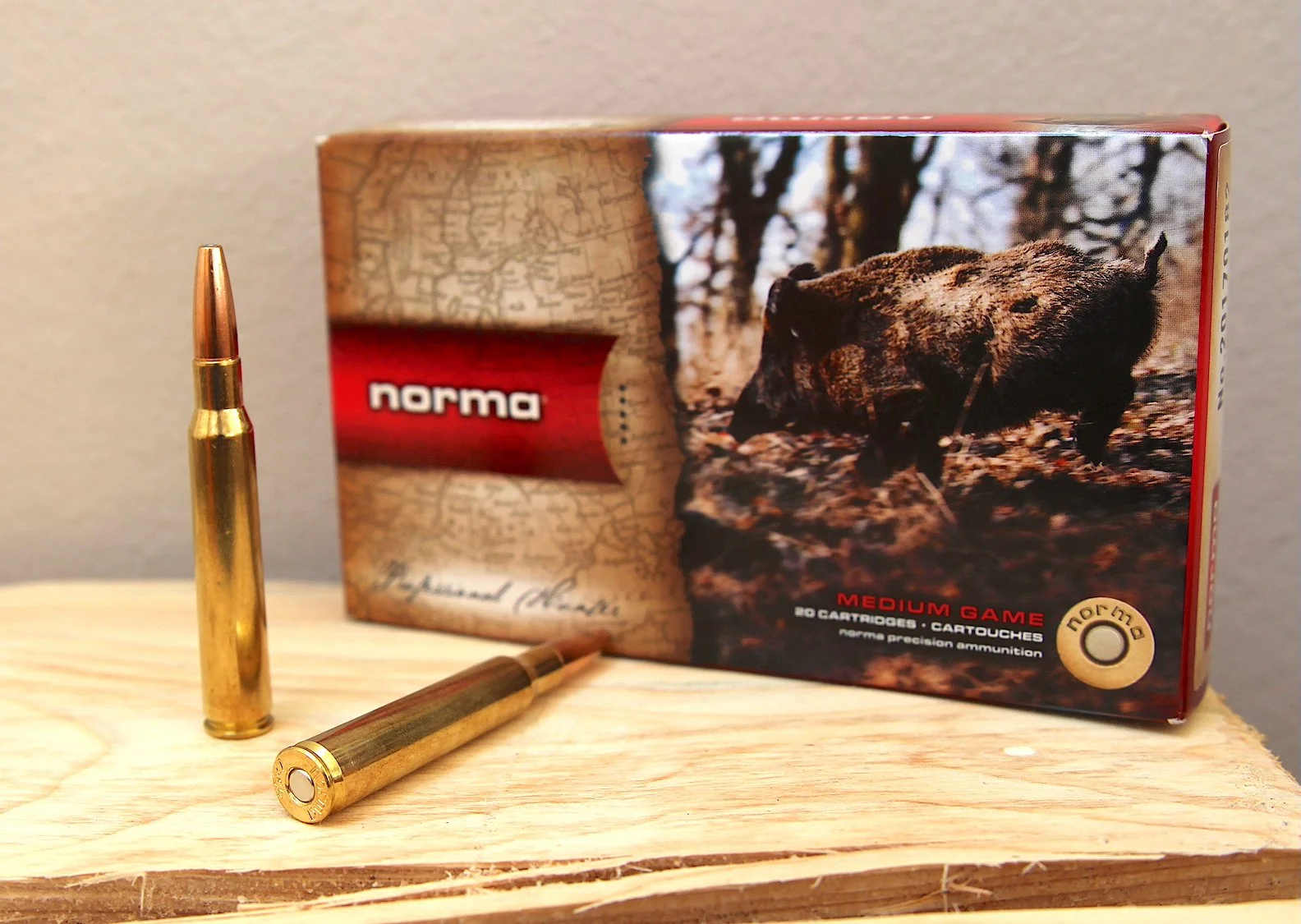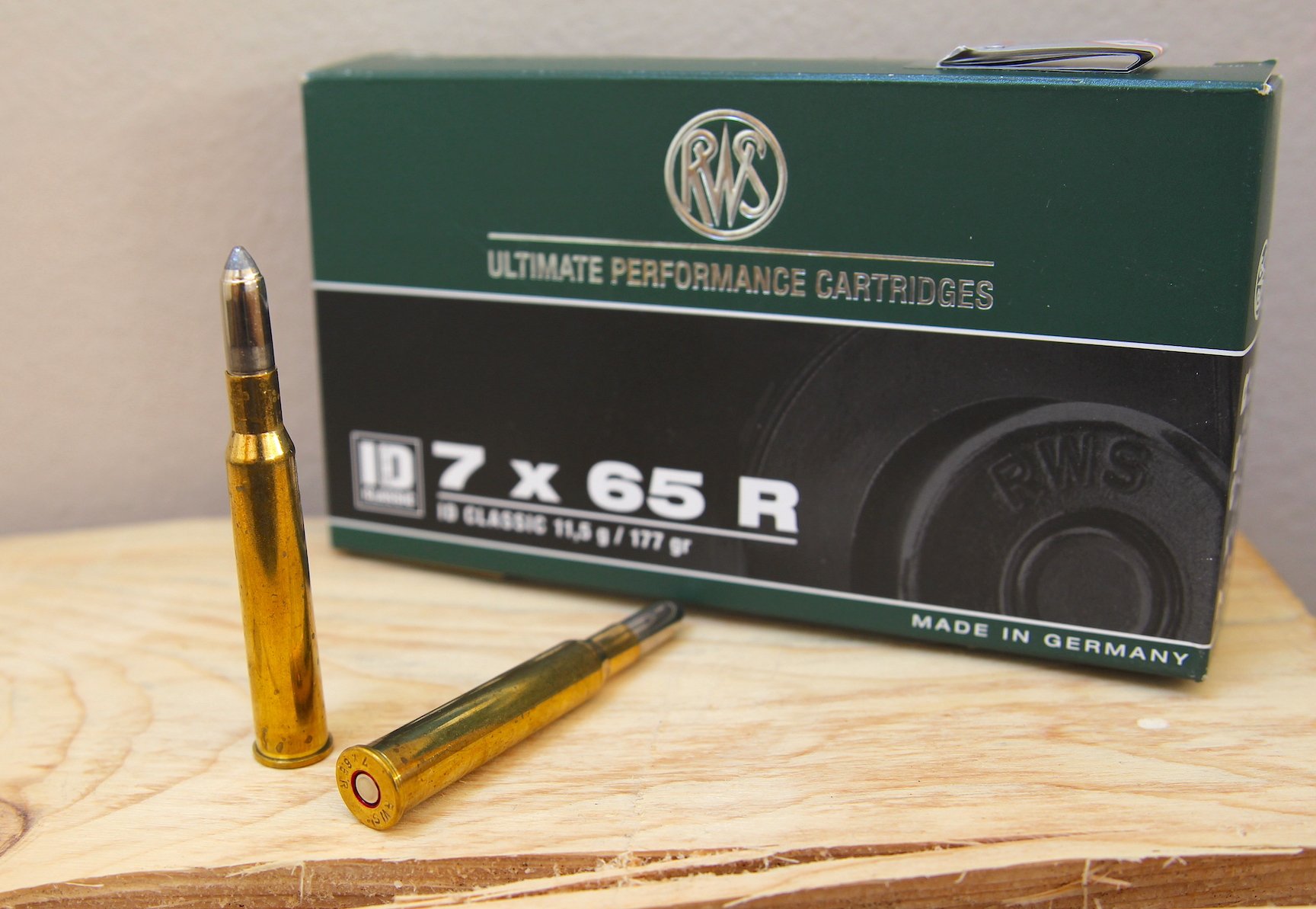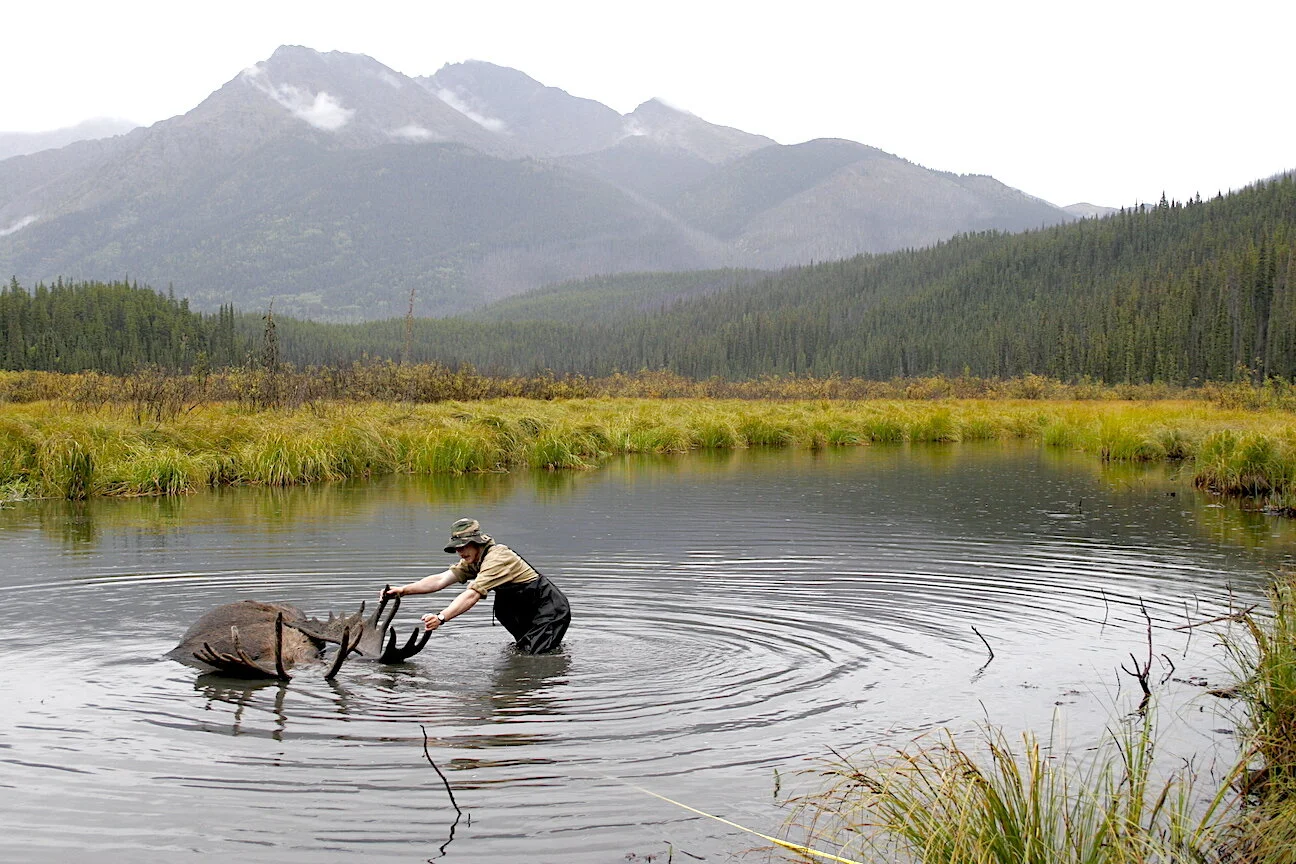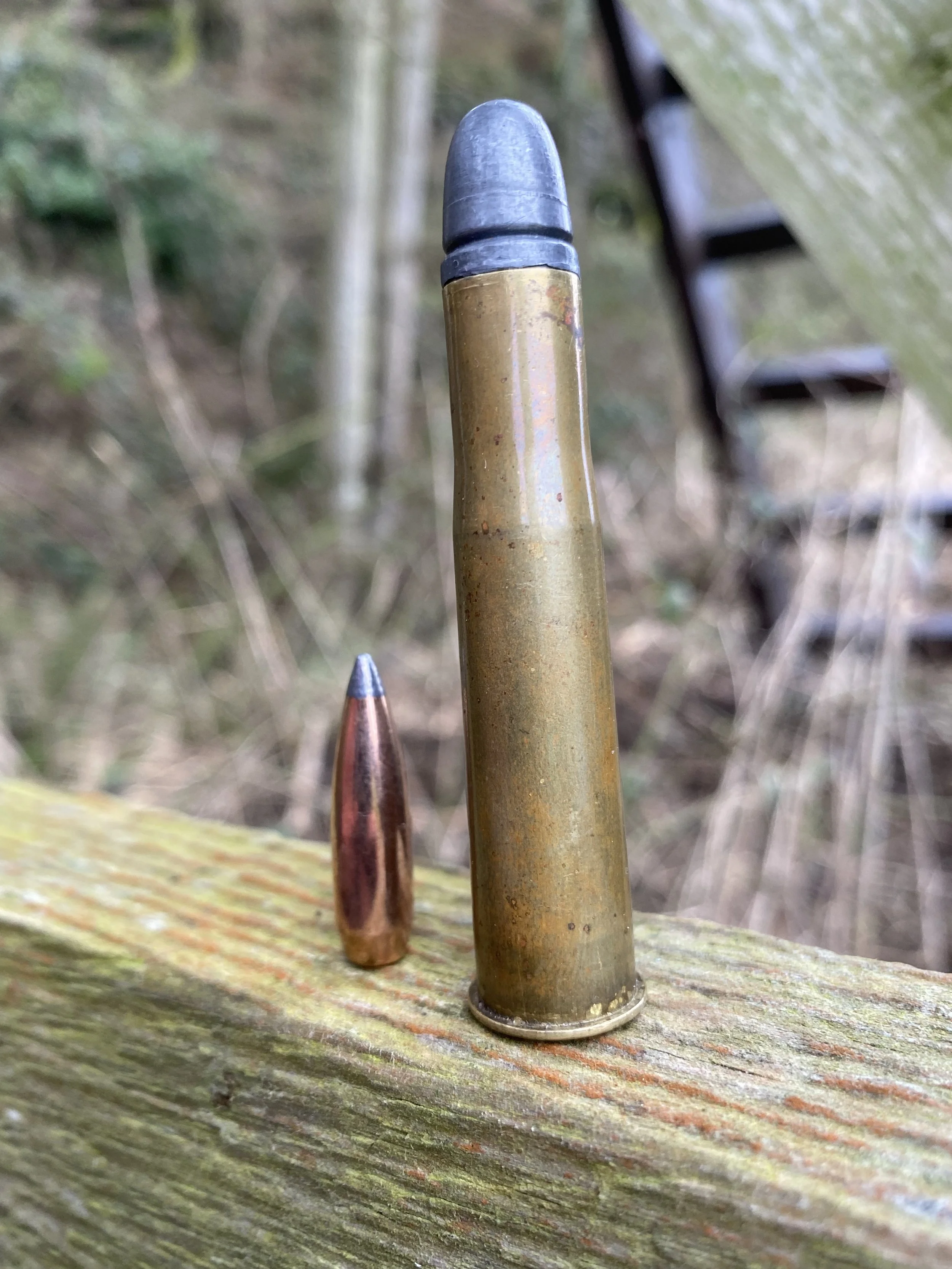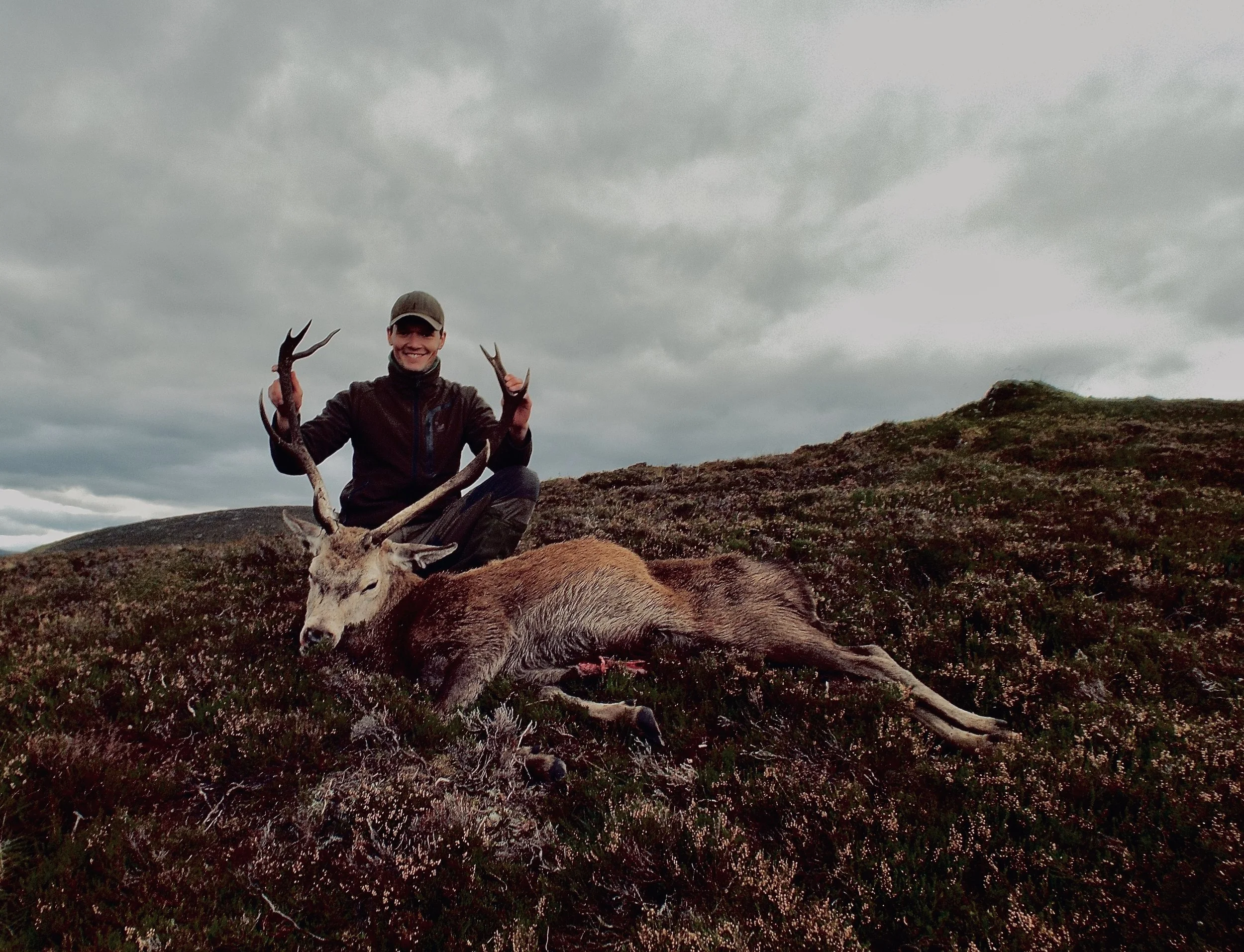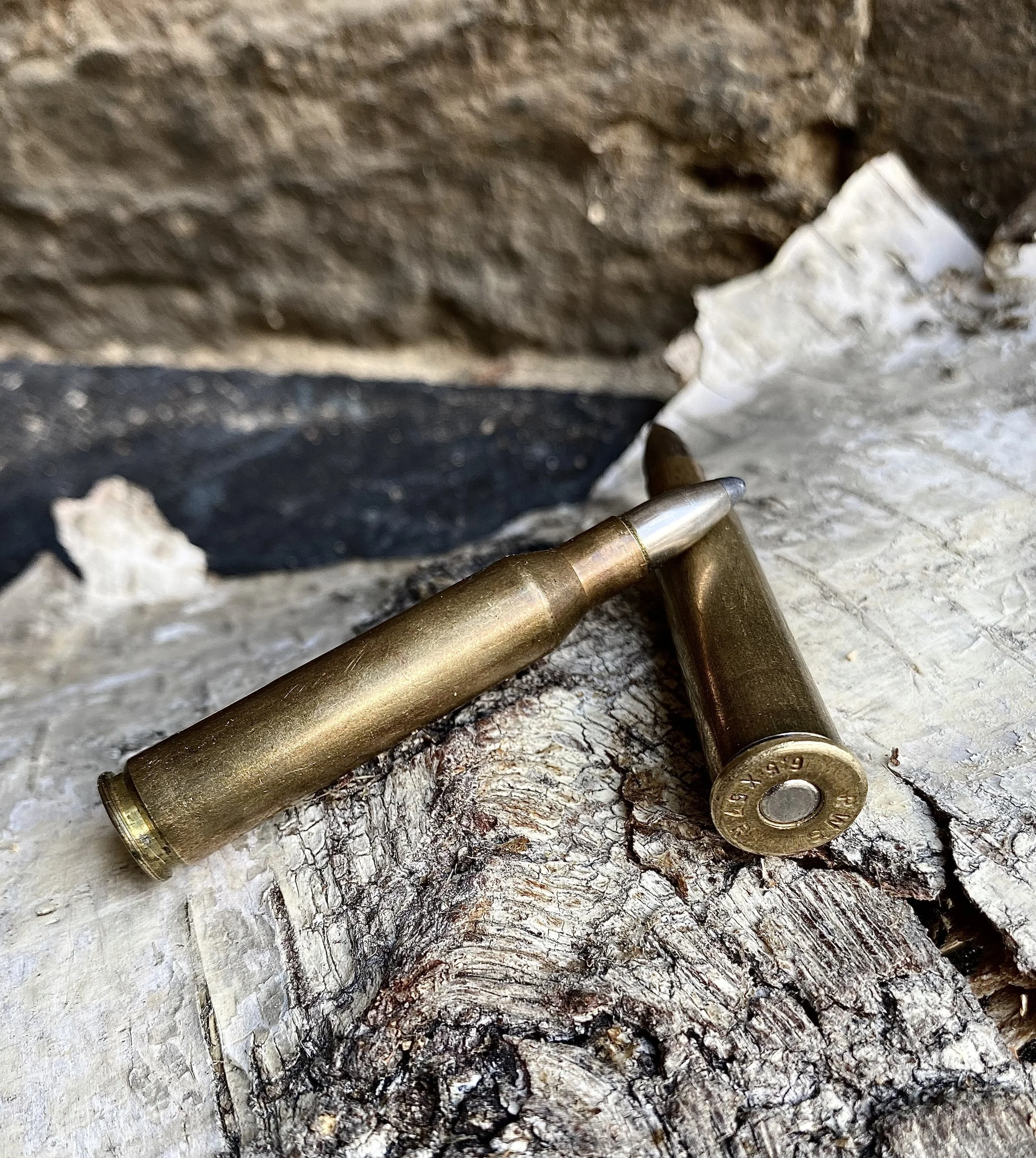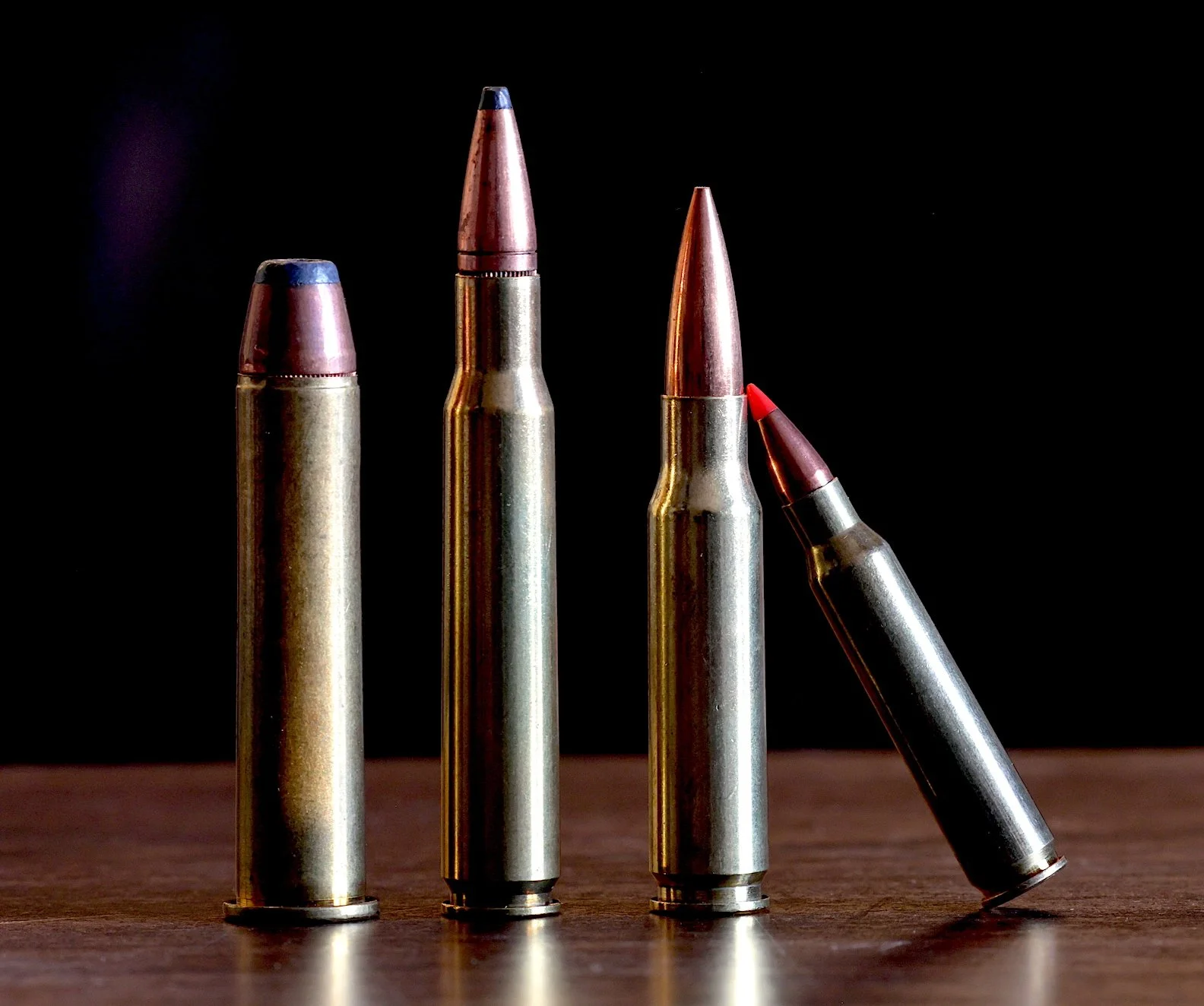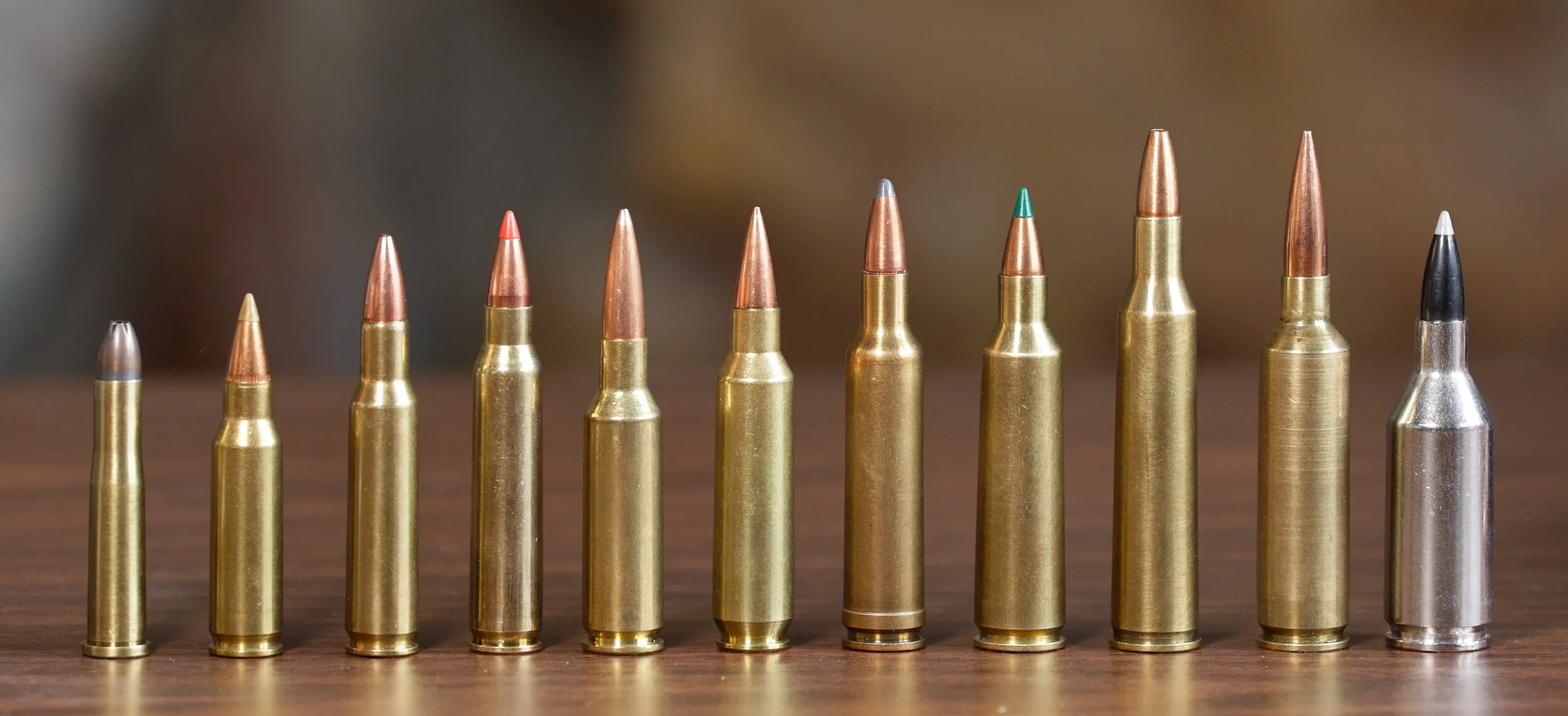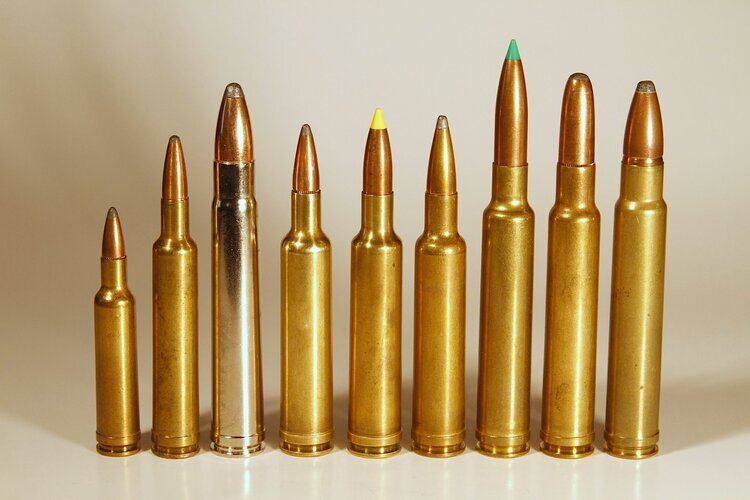Two 7mm Cartridges You May Not Know
The 7x64 Brenneke at far right and the rimmed 7x65 Brenneke in the middle bear a suspicious resemblance to the 30-06 standing far left.
by Lukas Schulte
There is no shortage of .284 inch /.285 inch/7mm caliber rifle cartridges on the market. You probably know the 7mm Remington Magnum, the 7x57mm Mauser, the .280 AI, the .280 Remington, the 7mm WSM, the 7mm-08 Remington, and the .28 Nosler, and four or six others. But how about the 7x64 Brenneke? Or the 7x65R?
These two European cartridges might sound foreign to US shooters, but their ballistics have them running heel and toe with more popular American cartridges. And they preceded the release of their US counterparts, as we’ll soon describe.
The European 7mm Bullet Difference and the 7x64 Brenneke
European 7mms usually use .285 inch/ 7.25 mm bullets while American cartridges use the .284 inch/ 7.21 mm diameter. They all drive bullets towards medium-sized big game animals with great success, some faster, some slower.
With so many already on our radars, why bother with yet another, the German 7x64mm? Well, maybe just for the fun of it. I enjoy learning about new stuff, especially in the world of hunting cartridges. And if some interesting history goes along with it, that’s even better.
So let’s have a look at this 7mm cartridge that has been around since 1917. The 7x64mm was developed by famous German ammunition and bullet designer Wilhelm Brenneke. Brenneke was driven to build hunting cartridges and bullets that would reliably kill without unnecessary suffering. He studied conventional case designs and tried to increase kinetic energy and speed by lengthening and widening them for greater capacity. One of his earliest inventions was the 8x64mm of 1912 for which he used the 8mm S-bore diameter (.323 inch). Although it was a ballistical upgrade over the 8mm Mauser of 1905, the design did neither catch on with hunters nor the military.
Brenneke believed in his principles and kept on experimenting, necking down his 8mm case to hold 7mm bullets. The product became one of his most successful inventions, the 7x64mm. It bested the speed and energy of the highly respected 7x57mm Mauser by around 10%, offering a flatter trajectory and more punch-down range. It was often described as a miraculous cartridge, which probably reflected Brenneke’s and others’ new bullet designs that went along with the introduction of the cartridge.
7x64 Brenneke Takes Off
Hitting game with faster and more powerful bullets of sound construction was the recipe for commercial success. Between the two world wars, 7x64mm popularity and sales figures soared. That led to a wide array of factory loads which made it easy to find a suitable load for most hunting scenarios.
This 7x64 Brenneke looks like a 30-06 or 280 Remington because its length, width, taper, and shoulder angle are remarkably similar to those US cartridges. Brenneke can perhaps take credit for showing Remington the way for its 280 Rem. cartridge of 1957, but the 30-06 potentially enlightened Mr. Brenneke when he created his 7x64.
There is nothing miraculous about this 7mm cartridge; it just does what it is supposed to. When used within its capabilities it offers a great blend of strength, speed, flat trajectory, shootability, and bullet choices. Used inappropriately, for example on steep-angled quartering shots at heavy critters or with the wrong bullets, Brenneke’s 7mm is no better than others.
The name of the cartridge says a lot about its dimensions. The .285 inch bullets sit atop a 64mm long case, which is 2.559 inches. The maximum overall length is 84mm/3.307 inches, thus it fits standard-length actions. Case capacity is 69.9 grains of water. That is quite a bit of room for slow-burning powders. Case shoulders at about 20-degrees combined with a bit of body taper eliminate feeding issues, even under extreme conditions. The case dimensions are a product of their time — slim and a bit tapered rather than fat with straighter walls and shaper shoulders favored in today’s precision shooting cartridges. For practical hunting purposes, the 7x64 case form is more of an advantage than a disadvantage. The slimmer shape makes it easier to build magazines for 4 or even 5 rounds. This comes in handy on driven hunts, hog hunts, and culling operations.
Aiming for Military Contracts
Brenneke tried to convince the German military to use his 7mm rather than the 8mm Mauser. The military considered the 7x64 due to its superior ballistics but ultimately decided the benefits were not worth the hassle of changing all its service rifles. Near the end of WWII, the Brenneke was considered for a sniper rifle, but it never made it into production. To this day, the cartridge remains a civilian cartridge only.
Moving to America — Not
As expected, The 7x64 never “made it” in North America, but it did eventually inspire a copycat. (More on that below.) In Europe, it was one of the go-to cartridges of the day, one of the best cartridges for anything from small roe deer to chamois, red deer, wild boar, and even moose. It was a top seller well into the 1970s and is still widely used, partly because some countries don’t allow civilians to own military cartridges. But after the 1970s it took a step back to make room for the increasingly popular 30-06 and 308 Winchester. Their advantage was wide distribution across the globe, ammunition widely available in even the smallest shops in the most remote places. As traveling for hunting adventures became more and more common, shooting a .30 caliber rifle at home and around the world made a lot of sense.
Something for Everything
Despite the 30-caliber surge, every European gun maker offers models in 7x64mm. Hunters on any budget can find a new gun or something nice in the used gun market. From cheap to expensive, heavy to light, long-barreled to short, there is a 7x64 Brenneke for everyone.
Factory ammunition features bullets from 120- to 177-grains, offering plenty of choices for all species. The 120- to 140-grain bullets are perfect for flat, open country roe deer or high country chamois. The 140- to 177-grain bullets of medium to hard construction are great choices for everything bigger. There are quite a few lead-free bullets, so hunters in lead-free states have no problem, either.
Handloaders can go as light as 100 grains for varmints or as heavy as 195 grains (for example the Berger Elite Hunter bullets) for long-range performance or heavy critters.
For the most part, American .284-inch bullets can be used in the 7x64 Brenneke without accuracy suffering. Due to the fast twist rate of 1 in 8.66-inch, heavy bullets are properly stabilized, too. This is a definite advantage compared to the 270 Winchester, which has similar power and ballistics but can’t stabilize bullets much heavier than 150-grains.
Although it is not labeled as a magnum cartridge, it definitely needs longer barrels of 24 inches to reach its potential. Launching its bullets from shorter barrels will result in a definite speed loss.
On the North American continent, I see the 7x64mm shine on hunts for deer, pronghorn, or mountain game. But even the biggest bull elk will fall to a well-placed 7mm bullet. Feral hog habitat is a perfect playground for this cartridge, too. It would not be my first choice for moose or the big bears, but these species have been humanely killed with this or comparable cartridges over the years. In Scandinavia, hunters still successfully use the 6.5x55 Swedish for moose hunting, so a 7mm cartridge is certainly up to the task. Black bears, regardless of the hunting method, can be tackled with the 7x64 Brenneke.
Most African plains game is fair game for the 7x64 and the right bullet. Eland, bongo, and buffalo (if legal) are probably too large to call the 7x64 a perfect fit, but no other horn-carrying African animals pose too big a challenge. Leopard hunting calls more for precise shooting than massive power, so the 7x64 could certainly work. Any wounded leopard wouldn’t be the cartridge’s fault so much as the shooter’s.
7x64 Brenneke vs. 7mm Remington Magnum
Now I guess what you really want to know is how the 7x64mm stacks up against its competitors. It seems reasonable to compare it to the American 7mm cartridge, the 7mm Remington Magnum. Clearly, the Remington is faster and carries more kinetic energy when comparing identical weights. But let’s have a closer look nonetheless.
A 177-grain TIG-bullet (Torpedo Ideal Geschoss, also an excellent Brenneke invention) flies from the 7x64 at 2,789 fps for around 3,061 ft-lbs of muzzle energy. Hornady 140 grain GMX bullets loaded in their Superformance product line hit 2,705 ft-lbs with a speed of 2,949 fps, while their 165 grain SST‘s bring 2,818 ft-lbs of energy at 2,798 fps.
From a 7mm Rem Mag a 177-grain TIG has a speed of 2919 fps, hitting with 3,359 ft-lbs. This is roughly 10% more energy than the 7x64mm carries with the same bullet loaded by the same company. The 7mm Rem. Mag. is more powerful. But that comes at a cost. Not surprisingly, the Rem. Mag. kicks harder and barks louder burning 17% more powder to gain 10% more velocity than the Brenneke. That’s not what I call efficient. It’s also noteworthy that the 7mm Rem. Mag’s. advantage depends on 26-inch barrels, while the 7x64mm works fine with 24-inch tubes. You need to decide if the power advantage is worth the costs.
7x64 Brenneke vs. 280 Remington
Finally, we address the elephant in the room: the 280 Remington. This necked-down offspring of the 30-06 has been called a 7x64 Brenneke rip-off ever since it appeared in 1957, a half-century after the Brenneke. Both rounds are so similar you have to look closely to see the differences when they’re perched side-by-side. Both shoot the same bullets to similar velocities. The 280 is usually chambered in 1:10 twist barrels, but ultimately the differences between the two are more theoretical than practical.
Overbore cartridges like the .28 Nosler and 7mm Remington Ultra Magnum exceed the capabilities of all these cartridges but play in a different league anyway. Brenneke’s invention sits in the middle of the pack with the bonus of a fast twist accommodating heavy for caliber, high B.C. bullets. And time tested since 1917. Not a bad place to be.
Bonus Round: Rimmed Version for Single Shots
In 1920, Brenneke presented the 7x65mmR as a rimmed version for break action rifles such as drillings and rifle-shotgun combination guns. Even light single shots for mountain hunting are available and can easily be mastered, recoil-wise. As with most “rimmed sisters” of rimless cartridges, the 7x65 R Brenneke is intended for slightly lower chamber pressure. Old break actions from yesteryear were not as robust as bolt action rifles, and the reduction in pressure ensured safe use without stressing materials too much. That undeniably leads to reduced speed and energy when compared to the rimless sister cartridge, although the difference is no big deal. We’re talking about something like 5%, so it handles the same tasks. It has a good reputation itself, and what can be said about the 7x64’s performance is true for the 7x65mmR, too.
Brennke built his 7x65 R. shortly after his rimless 7x64 to provide similar ballistic performance for European hunters using various break-action single shots and drillings. The rim provides a better connection for such rifle’s extractors than do rimless cases.
There are definitely fewer 7x65R factory loads on shelves, but the available ones offer everything a hunter realistically needs. American manufacturers usually don’t load this cartridge, but the bigger European ones all do. Handloaders have all the .284/.285 bullets to play with.
My own first hoofed game animal fell to a single shot from a drilling chambered in 7x65mmR a long time ago. It was a one-shot kill of a feral goat at the foot of a Scottish hill in my father’s hunting lease. The experience shaped me as a hunter, and I learned to appreciate drilling guns and the venerable German 7mm‘s. My brother took a shot at another goat a year later. Same gun. Same result. Over 15 years later, on a hunt for wild boar and deer in Hungary, I used a Mannlicher bolt action rifle in 7x64mm to down a boar and an antlerless deer. One dropped in its tracks, the other made it 50 yards before going down for good. That particular gun offered superb accuracy with the TIG bullet, as we proofed at the range. And though today I do the majority of my hunting with .30-06s, I must admit that both German 7mms can and will do anything the American classics do.
P.S.
How cool would it be to show up in deer camp with an “oddball” 7x64? And doubly cool to carry a 7x65R in a drilling? You’d be the star of the camp! Most hunters on the western side of the Atlantic will probably never see, let alone shoot one of these cartridges, but I’m betting those who do will come to appreciate them. If you are ever offered a quality gun in 7x64 or 7x65R at a fair price, grab it. I’m betting you won’t regret it.
About the Author
Lukas Schulte is a veterinarian in his thirties who graduated in 2014. He now lives and works in the greater Cologne area in western Germany. Besides treating sick animals, he, his wife, and their cocker spaniel Otis enjoy hiking, hunting and traveling with a rooftop tent. They fell in love with Scandinavia, Sweden in particular. When hunting, Lukas loves to pursue roe deer and wild boar, but also tries to visit a different country and hunt a new species of big game each year.



